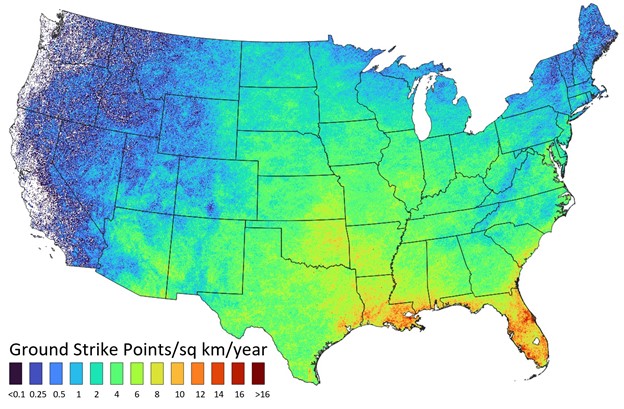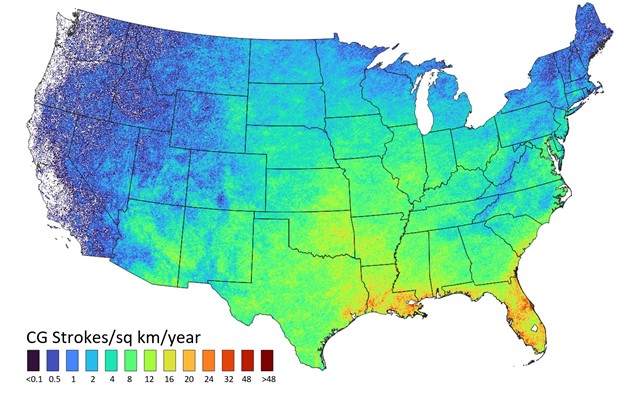Player FMアプリでオフラインにしPlayer FMう!
Chris Vagasky, University of Wisconsin – Lightning Safety
Manage episode 424170624 series 2459839
 Some places get more than others, but lightning is always dangerous.
Some places get more than others, but lightning is always dangerous.
Chris Vagasky, research program manager at the University of Wisconsin, explores this natural phenomenon.
Chris Vagasky is the manager of the Wisconsin Environmental Mesonet, a growing network of weather and soil monitoring stations in the state of Wisconsin. He is an active member of the American Meteorological Society and National Weather Association. Chris also serves on the National Lightning Safety Council as a lightning data and safety specialist, working in the United States and around the world to increase awareness of lightning safety.
Lightning Safety
https://academicminute.org/wp-content/uploads/2024/06/06-18-24-Wisconsin-Lightning-Safety.mp3Lightning is the natural hazard people experience most frequently. It flashes somewhere around the world more than 60 times every second – in every thunderstorm, in volcanic eruptions, and in hurricanes and snowstorms. Lightning is hotter than the surface of the sun and delivers thousands of times more electricity than the power outlet that charges your smartphone. And because it comes out of the sky at more than 200,000 miles per hour, you can’t get out of the way if it decides to strike where you’re standing. Lightning is beautiful but dangerous, so knowing where and how often it hits ground can help meteorologists and engineers keep you safe from nature’s largest spark.
You may have heard that lightning doesn’t strike the same place twice, but it can, and often does. Look out the window during a thunderstorm and you’ll see that. The lightning appears to flicker and some of those flickers hit the same spot on the ground, while others may hit up to 6 miles away. The U.S. National Lightning Detection Network, which detects at least 97% of the cloud-to-ground lightning that occurs nationwide, has allowed us to count each of those flickers and where they contacted the ground with high precision.
Using six years of data from the National Lightning Detection Network, we have counted an average of 36.8 million ground strike points each year, hit by more than 55 million lightning strokes – those individual flickers of lightning you see when it flashes. The areas along the Gulf Coast and the southeast and in Tornado Alley are most prone to cloud-to-ground lightning, but lightning can occur anywhere in the country. Lightning kills an average of 28 people in the United States each year, so it’s important to remember that no matter where you are, when thunder roars, go indoors!


The post Chris Vagasky, University of Wisconsin – Lightning Safety appeared first on The Academic Minute.
283 つのエピソード
Manage episode 424170624 series 2459839
 Some places get more than others, but lightning is always dangerous.
Some places get more than others, but lightning is always dangerous.
Chris Vagasky, research program manager at the University of Wisconsin, explores this natural phenomenon.
Chris Vagasky is the manager of the Wisconsin Environmental Mesonet, a growing network of weather and soil monitoring stations in the state of Wisconsin. He is an active member of the American Meteorological Society and National Weather Association. Chris also serves on the National Lightning Safety Council as a lightning data and safety specialist, working in the United States and around the world to increase awareness of lightning safety.
Lightning Safety
https://academicminute.org/wp-content/uploads/2024/06/06-18-24-Wisconsin-Lightning-Safety.mp3Lightning is the natural hazard people experience most frequently. It flashes somewhere around the world more than 60 times every second – in every thunderstorm, in volcanic eruptions, and in hurricanes and snowstorms. Lightning is hotter than the surface of the sun and delivers thousands of times more electricity than the power outlet that charges your smartphone. And because it comes out of the sky at more than 200,000 miles per hour, you can’t get out of the way if it decides to strike where you’re standing. Lightning is beautiful but dangerous, so knowing where and how often it hits ground can help meteorologists and engineers keep you safe from nature’s largest spark.
You may have heard that lightning doesn’t strike the same place twice, but it can, and often does. Look out the window during a thunderstorm and you’ll see that. The lightning appears to flicker and some of those flickers hit the same spot on the ground, while others may hit up to 6 miles away. The U.S. National Lightning Detection Network, which detects at least 97% of the cloud-to-ground lightning that occurs nationwide, has allowed us to count each of those flickers and where they contacted the ground with high precision.
Using six years of data from the National Lightning Detection Network, we have counted an average of 36.8 million ground strike points each year, hit by more than 55 million lightning strokes – those individual flickers of lightning you see when it flashes. The areas along the Gulf Coast and the southeast and in Tornado Alley are most prone to cloud-to-ground lightning, but lightning can occur anywhere in the country. Lightning kills an average of 28 people in the United States each year, so it’s important to remember that no matter where you are, when thunder roars, go indoors!


The post Chris Vagasky, University of Wisconsin – Lightning Safety appeared first on The Academic Minute.
283 つのエピソード
すべてのエピソード
×プレーヤーFMへようこそ!
Player FMは今からすぐに楽しめるために高品質のポッドキャストをウェブでスキャンしています。 これは最高のポッドキャストアプリで、Android、iPhone、そしてWebで動作します。 全ての端末で購読を同期するためにサインアップしてください。




